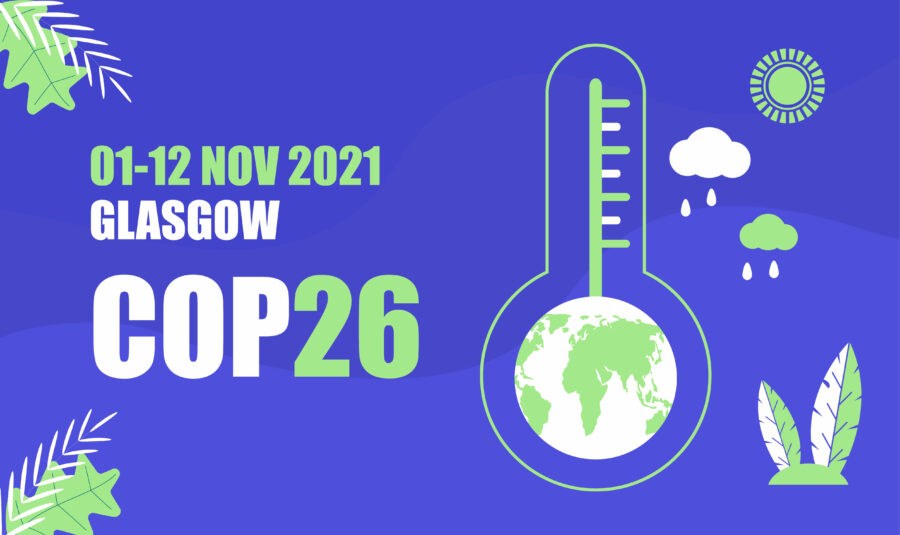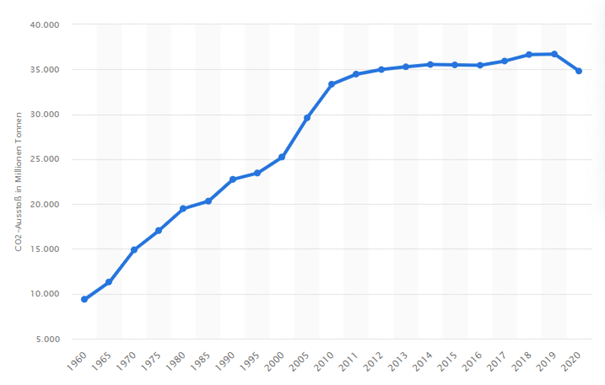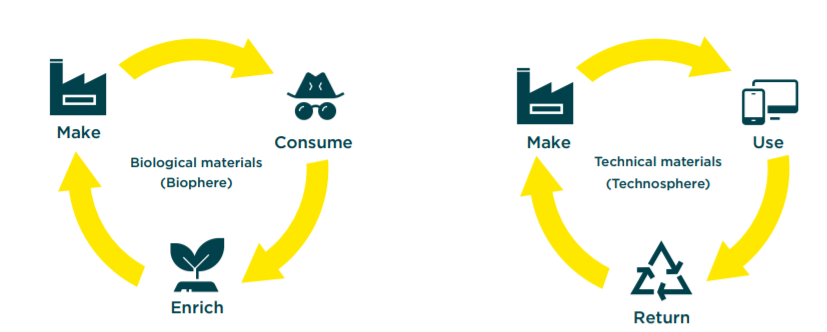
COP26 and the Circular Economy
Sustainability and Circular Economy
“Sustainable development is development that meets the needs of the present without risking that future generations will not be able to meet their own needs.” – World Commission on Environment and Development [18]
For more than 100 years now, people have been talking about resource depletion, poverty, political instability or the challenges of (over)population [1]. To keep our planet (habitable) for future generations, it is essential to address these challenges [2] that endanger our world [3].
We also feel it directly, most of all we feel the changes in the climate. The more global warming increases, the more often we experience extreme weather conditions and environmental disasters. Also supply shortages can arise. The Rhine, for example, is one of the major trade routes for food imports to Switzerland. When dry periods last too long, the water level is not always sufficient for the transport ships, which led to a shortage in the feed sector in 2003 [31].
The fact that we are facing major climate challenges is something we hear and read about in newspapers, at events, on social media and via organizations that are campaigning for climate protection – and we feel it in our everyday lives.
Nevertheless, the concept of sustainability must not be short-changed. Sustainability describes the idea of continuously preserving the world not only in ecological terms, but also in economic and social terms [1]. Related to the corporate level, corporate sustainability defines the goal of positively managing environmental, social, and economic impacts [5] in order to reduce the company’s negative impact on its environment, e.g., through CO2 emissions or unfair wages, and also to contribute to a stable macroeconomic situation through sustainable economic activity, e.g., by reducing unemployment. For example, the term “Environmental Social Governance (ESG)” has become established in the financial industry as a standard of sustainable investment. Environmental Social Governance (ESG) specifies principles that include environmental and social aspects as well as governance guidelines that companies can integrate into their business activities [6].
The Circular Economy aims to achieve precisely this corporate sustainability.
The Glasgow Conference and its decisions have prompted us to consider the sustainable development of our planet and the extent to which the Circular Economy can contribute to achieving climate goals. In the following, we first look at the climate challenges and the developments of the Glasgow Conference and then take a look at how companies can contribute to a more sustainable development of the economy by transforming their production according to the principles of the circular economy.
At What Level Must the Fight Against Global Warming Take Place?
The climate changes make us think. As an individual, one often feels somewhat powerless in the face of the magnitude of the problem; one has the feeling that as an individual one can hardly make a difference. And yet, for many people, addressing the issue leads to positive behavioral changes (regional shopping, separation of waste, increased consumption of seasonal fruits and vegetables). Such individual changes are also relevant to better achieve desired goals such as the net zero initiative – but they are not enough by far. Larger, more radical economic and social changes are needed to address one of the greatest transformations since industrialization.
In order to achieve this, various organizations have already taken up the topic a long time ago and are trying to improve sustainability in this world through cooperation, regulations, prevention and contractual agreements. Although climate-related issues are only part of the picture and, as mentioned above, there are also social and economic challenges, such as global inequalities, high unemployment, unfavorable working conditions, and financial instability [4].
The Club of Rome organizations or the Paris Agreement are just two of many ventures trying to create a better world.
Club of Rome
Since the 1970s, the Club of Rome, an association of 100 (currently 101) experts from more than 30 countries, has been discussing and calling for a change in values in our society for a more sustainable world. The Club of Rome is one of the world’s most renowned think tanks for sustainability strategies. The experts produce expert opinions and reports for the UN or the G7 leaders. [32]
UN Climate Conferences
It was 30 years ago that the Climate Change Conference was first held, leaders from around the world came together to address climate change for the first time. The Paris Agreement, for example, is a result of such a climate conference and commits every country that signs to reduce greenhouse gas emissions [17]. For the past 30 years, global leaders have met annually (except in 2020 because of the pandemic) to discuss how to keep global warming well below 2 degrees Celsius above pre-industrial levels and what efforts they are making to limit the temperature rise to 1.5 degrees Celsius [17].
Paris Agreement
The Paris Agreement is an international treaty established in 2015 at one of the climate conferences and signed by 189 of 196 countries. It has three goals: It seeks to limit global temperature rise to 1.5 degrees, reduce greenhouse gas emissions to that end, and it seeks to align financial flows with climate goals and move away from carbon-intensive investments. [33]
What Happened in Glasgow?
From October 31 to November 13, the 26th UN Climate Change Conference (COP26 “Conference of the Parties”) took place in Glasgow, Scotland. More than 20,000 participants attended the two-week meeting, government representatives from all countries worked together to define measures and targets for reducing greenhouse gas emissions by 2030 (Glasgow 2030 Climate Pact), discussed financial resources for climate protection measures and deliberated on measures to counter the effects of climate change. For a better world and for the fight against the climate crisis [16]. In the final documents, the industrialized countries commit to investing $100 billion in climate protection over the next 5 years, similar to what was already negotiated from 2009 to 2020. Germany has drawn up a plan for how the money is to be invested.
How Do We Achieve the 1.5 Degree Target?
Limiting the temperature rise to 1.5 degrees Celsius is, in the view of scientists, the best way to prevent dangerous effects from global warming. However, it is clear that a temperature rise is taking place worldwide and we are not yet on the right track. Many countries are far from reaching the 2030 targets. According to a United Nations report, CO2 emissions at the end of this decade will be 16% higher than in 2010, even if all countries meet their reduction targets [19]. Thus, we are heading for a warming of 2.7 degrees Celsius (by the year 2100) if countries do not introduce further measures, which would be catastrophic (e.g., glacier melt, rising sea levels, flooding, etc.) [20].
At COP26, clear goals and measures were supposed to be defined to counteract global warming. However, according to Simonetta Sommagura’s statement in an interview with SRF radio about the meeting in Glasgow, the intended goals have not been achieved. A rapid CO2 reduction is not taking place and she is not satisfied with the result. On a few points, positive things could be reported, such as the writing down of the global coal phase-down and the doubling of subsidies for poorer countries suffering from the consequences of climate change (droughts, hurricanes, etc.) from 20 to 35 billion dollars [21]. Thus, at this stage, although countries are taking action and trying to protect the climate, the climate conference has been able to initiate few implementation actions. Too many countries are still unwilling to reduce their greenhouse gas emissions [22].
How Does It Look Worldwide?
Global CO2 emissions have increased steadily since the 1960s [27]. While 10,000 million tons of CO2 were emitted in the 1960s, by 2020 the figure has more than tripled to 35,000 million tons of CO2. According to a forecast, CO2 emissions will exceed 43,000 million tons of CO2 in 2040. The increase in emissions causes the temperature to rise and thus leads to natural disasters.

Looking at the individual continents, the share of CO2 emissions is highest in Asia, followed by the USA and Europe. Switzerland emits about 40 million tons of CO2 per year, while China, for example, emits over 11,000 million tons of CO2 per year. However, if we look at emissions per capita, the picture changes a lot, as China has about 180 times more inhabitants than Switzerland: the difference between China and Switzerland becomes smaller. In 2018, Switzerland had a per capita emission of about 4.5 tons of CO2 and China of about 7 tons [28]. For further comparison, Germany was above China at just under 8 tons, as was the U.S., which had per capita CO2 emissions of about 14.5 tons in 2018. To get a halfway grip on climate change, a report by the Intergovernmental Panel on Climate Change recommends reducing annual CO2 emissions to 1 to 2 tons per capita. Individual countries exceed this figure by more than 30 times [29]. Nevertheless, it is logical that reductions in the countries that emit the most CO2 in relation to their population worldwide will make the biggest difference in the fight for a better climate.
Technical progress should make it possible to further reduce emissions. Hopefully, this will also succeed, but “technical progress” should not necessarily be equated with “digitization”. Large energy guzzlers such as cryptocurrencies or the streaming of movies via the well-known platforms contribute just as much to the high emission figures worldwide. In 2018, streaming via video-on-demand platforms such as Youtube, Netflix & Co, porn sites or social media (Instagram & Co.), which together account for about 80% of data traffic with roughly equal shares of 20-30% [30], emitted more than 300 million tons of CO2. It can thus be assumed that the business models of social media and content platforms (the aforementioned digitization) and climate protection are going in different directions [16].
The problems are far-reaching and the challenges for the next few years are high, but there is a lot that can be done privately and politically to protect the climate. On the one hand, bans can be introduced, such as the abolition of oil heating or the establishment of car-free zones, on the other hand, a dialogue with the population for education, for participation in climate protection is an important component. At the level of the individual, a change in consumption behavior is important, whether this is done of one’s own free will or through bans and regulations, both of which aim to reduce greenhouse gases. Knowing that entire industries can be changed by abstaining to some extent presents both opportunities and risks for climate protection (e.g., abstaining from meat can lead to the dismantling of animal farms). Another part is rethinking the system of producing goods and services. This is where the circular economy comes in.
Circular Economy
Although governments, policymakers, and businesses are already addressing the challenges mentioned, it is clear that current sustainable measures, such as net-zero initiatives, are necessary but not sufficient to meet ambitious climate goals or resolve existing and upcoming resource conflicts [7]. New concepts and approaches are needed. One of them is the circular economy; it decouples the growth of resource consumption from the associated environmental problems. Thus, future implementations of sustainability strategies are considered in a larger context [8]. The awareness of this approach is increasing, which is very encouraging [9].
A circular economy is a regenerative system that seeks to use and reuse resources and materials multiple times in a closed-loop manner [10] while pursuing the long-term goal of closing resource loops and minimizing resource consumption [11]. The overall concept takes into account not only sustainable factors (e.g., how to minimize resource demand), but also economic aspects, i.e., how new business models can protect the climate [8]. In addition, the concept creates a shift in mindset to minimize negative and maximize positive environmental impacts (from design of products to recycling) [12].

Figure 4 illustrates the cycle. Residual materials within the biosphere are recycled by industrial processes or the natural environment and serve as a basis for further production [13]. In the technosphere, for example, efforts are made to extend the life of goods and prevent them from being taken out of circulation (e.g., second-hand market for smartphones) [13]. Recyclable headphones sold as a service, which are completely modular so that broken parts can be easily replaced, remanufactured, and installed in new headphones [15], are another example of the technosphere. A good example of the biosphere is the application of “mechanical-biological treatment” to organic household waste, the result of which is used to enrich the soil [14].

The transition from a linear economy to a circular economy should ideally lead to the reduction and reuse of waste and resources [13]. However, to enable a circular economy and transform our linear organized economy, new business models are required.
How Can the Circular Economy Help Us Achieve Climate Goals?
A circular economy, as mentioned above, is a model that minimizes waste and maximizes the use of natural raw materials. Reuse and recycling extend the value chain of products [23]. Thus, one can highlight the following aspects:
- Pollution and waste are already taken into account in the design and creation of products and are avoided as far as possible.
- Materials and products are reused, repaired or remanufactured to maintain the cycle.
- Nutrients are returned to the ecosystem through a transformation of existing thinking and focus on positive impact for the environment.
But how can a circular economy contribute to climate protection? [24] Through circular economy methods and the efficient use of resources, CO2 and greenhouse gas emissions can be reduced. Some examples of how this can be done / how this is currently done [24], [25]:
- In the vehicle life cycle, the aim is to achieve net zero CO2 emissions. To achieve this, for example, low-CO2 materials are used and electricity for production is sourced from solar energy.
- To ensure that the vehicles are used for a longer period of time, the individual parts are reused where possible. Various usage proposals are also being created, such as subscription-based usage (mobility, car-sharing, etc.).
- The individual parts or semi-finished or finished products are made from recycled materials. In this way, CO2 emissions can be avoided (e.g. recycle electric vehicle batteries or use recycled plastic for shampoo bottles).
- Optimization of waste incineration plants to make them more efficient and thus prevent refurbishment. This keeps them operational for longer and protects the environment.
Conclusion
In conclusion, it can be stated [26]:
Unfortunately, the climate conference did not achieve the goals that many had hoped for. Financing issues were addressed and the coal phase-out was put in writing, but of course this does not solve the problems of the climate crisis. The circular economy offers a good approach for companies to produce and operate in a more climate-friendly way on this earth. However, to bring about ecological and economic improvements, a holistic view of all processes within the product life cycle is crucial. Private companies are important players that can contribute a great deal to maintaining livable conditions on earth and initiate positive changes. Exchange with and cooperation between authorities, companies, universities and residents certainly help in this regard.
Sources
[1] M. Robertson, Sustainability principles and practice, Third Edit. Routledge, 2021. [2] Robert W. Kates et al, “Sustainability Science,” Science (80-. )., vol. 292, no. 5517, pp. 641-642, 2001, doi: [2]https://www.science.org/doi/full/10.1126/science.1059386. [3] OECD, “OECD Environmental Strategy for the First Decade of the 21st Century,” 2001. [4] T. Jackson, Prosperity without growth? The transition to a sustainable economy. Sustainable Development Commission, 2009. [5] S. Schaltegger, “Corporate Social Responsibility in Municipal Enterprises,” Corporate Social Responsibility in Municipal Enterprises, 2011. . [6] J. Maniora, “Is Integrated Reporting Really the Superior Mechanism for the Integration of Ethics into the Core Business Model? An Empirical Analysis,” J. Bus. Ethics, vol. 140, no. 4, pp. 755-786, 2017, doi: 10.1007/s10551-015-2874-z. [7] Prof. Dr. Michael Braungart, “MAKING THE WRONG PERFECT AND THE PERFECT WRONG!” Business Circle – Marie-Astrid Schaffra, 2020. https://businesscircle.at/news/banken-versicherungen/das-falsche-perfekt-machen-und-das-perfekt-falsch/ (accessed Oct. 12, 2021). [8] W. McDonough, M. Braungart, P. T. Anastas, and J. B. Zimmerman, “Applying the Principles of Green Engineering to Cradle-to-Cradle Design,” Environ. Sci. Technol. vol. 37, no. 23, 2003, doi: 10.1021/es0326322. [9] G. Brennan, M. Tennant, and F. Blomsma, “Business and production solutions: closing loops and the circular economy,” Sustain. Key Issues, vol. 2050, pp. 219-239, 2015, doi: 10.4324/9780203109496-11. [10] Y. Geng and B. Doberstein, “Developing the circular economy in China: challenges and opportunities for achieving ‘leapfrog development,'” Int. J. Sustain. Dev. World Ecol. , vol. 15, no. 3, pp. 231-239, 2008, doi: 10.3843/SusDev.15.3:6. [11] W. R. Stahel, “The circular economy,” Nature, vol. 531, no. 7595, pp. 435-438, 2016. [12] T. Janssen, “For a Large Positive Footprint,” 2021. [13] Ellen MacArthur Foundation and the McKinsey Center for Business and Environment, “Growth within: a circular economy vision for a competitive europe,” 2015. [14] Eco-Business, “Compostable and biodegradable waste (bio waste) around us,” 2017. https://www.eco-business.com/press-releases/compostable-and-biodegradable-waste-bio-waste-around-us/ (accessed Oct. 01, 2021). [15] Metabolic, “Circular economy solutions for e-waste: headphones as a service,” 2019. https://www.metabolic.nl/news/circular-economy-solutions-e-waste-headphones-service/ (accessed Oct. 01, 2021). [16] www.Spiegel.de/klimawandel [17] https://www.consilium.europa.eu/de/policies/climate-change/paris-agreement/cop26/# [18] https://www.are.admin.ch/are/de/home/medien-und-publikationen/publikationen/nachhaltige-entwicklung/brundtland-report.html [19] https://www.bpb.de/politik/hintergrund-aktuell/342741/cop-26-un-klimakonferenz-in-glasgow [20] https://www.tagesschau.de/ausland/amerika/un-klimaziele-verfehlt-erderwaermung-101.html [21] https://www.srf.ch/play/tv/srf-news/video/ernuechternde-bilanz-aus-glasgow?urn=urn:srf:video:11a74eb3-4efb-4b09-b26e-97160c1cb125 HYPERLINK “https://www.srf.ch/play/tv/srf-news/video/ernuechternde-bilanz-aus-glasgow?urn=urn:srf:video:11a74eb3-4efb-4b09-b26e-97160c1cb125&aspectRatio=16_9″& HYPERLINK “https://www.srf.ch/play/tv/srf-news/video/ernuechternde-bilanz-aus-glasgow?urn=urn:srf:video:11a74eb3-4efb-4b09-b26e-97160c1cb125&aspectRatio=16_9″aspectRatio=16_9 [22] https://www.welthungerhilfe.de/aktuelles/blog/2021/cop-26-die-klimakonferenz-die-den-sueden-im-stich-lies/ [23] https://www.tempo-world.com/de-ch/leben-mehr/circular-economy-was-ist-eine-kreislaufwirtschaft/ [24] https://innovatives-brandenburg.de/de/nachhaltig-heute/kunststoff-recycling/kreislaufwirtschaft-schuetzt-das-klima [25] https://newsroom.accenture.de/de/news/accenture-und-world-economic-forum-kreislaufwirtschaft-kann-zu-einer-reduktion-der-co2-emissionen-um-bis-zu-75-prozent-in-automobilindustrie-beitragen.htm [26] https://www.economiesuisse.ch/de/dossier-politik/position-der-schweizer-wirtschaft [27] https://de.statista.com/statistik/daten/studie/37187/umfrage/der-weltweite-co2-ausstoss-seit-1751/#professional [28] https://edgar.jrc.ec.europa.eu/ [29] Global Carbon Atlas 2017; IPCC 2014 Assessment Report 5; IPCC 2014 Synthesis Vol. [30] https://theshiftproject.org/wp-content/uploads/2019/07/Excutive Summary_EN_The-unsustainable-use-of-online-video.pdf. [31] https://www.bafu.admin.ch/dam/bafu/de/dokumente/klima/externe-studien-berichte/klimawandel-im-ausland-risiken-und-chancen-fuer-die-schweiz-schlussbericht.pdf.download.pdf/Infras-Bericht_Auswirkungen-des-Klimawandels-im-Ausland.pdf [32] https://www.tagblatt.ch/international/denkfabrik-das-gewissen-der-welt-sitzt-in-der-schweiz-ld.928295 [33] https://de.wikipedia.org/wiki/%C3%9Cbereinkommen_von_Paris#Die_Ziele_des_%C3%9Cbereinkommens_im_Einzelnen [34] Commerzbank & Business Engineering Institute St. Gallen, “How API based Ecosystems can serve Circular Economy”, 2021. https://www.bei-sg.ch/_files/ugd/1ae519_748e16002967424796083ce5d684fba3.pdf (accessed Feb. 03, 2022)- The art of cooperation - 12.03.2024
- The Capability Compass - 05.12.2023
- Trends, trends, trends – nothing is as constant as change - 18.07.2023
